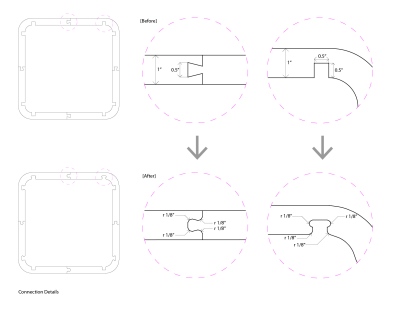jaeyual@mit.edu

I designed a modular book shelf with two types that can be stacked together. In the first cut-sheet, I forgot to incorporate the cutting radius of the drill bit and realized that I have to put in fillets with 1/8″ radius. For each modules, 11 layers of profile components are held by 8 structure components that hold them together with press-fit connection. Profile components are divided into 4 parts in order to conserve the sheet material.
Joints for the assembly of profile components are puzzle-like that they fit together. Joints in between two different components fit also in the same way but cross each other perpendicularly. Dog-bone fillets are made inside to incorporate the size of 1/4″ diameter drill bit and 1/8″ radius fillets are placed at the entrance of the socket to make the assembly easier.
[MOCK-UP TEST]
/Material : Medium-Density Fibreboard (30″ x 40″)
/Machine : CNC
/Location : 4-002
/Cutting time : 20 minutes
Joints between the profile component and the structure component worked out very well as they fit together very tightly. I was concerned about the dog-bone fillet as they take out about half of the actual meeting surface between the components, but it is working. The puzzle-like joints for the assembly of 4 parts into 1 profile component worked well for the most of them, but few of them got chipped out when pressing pressure to put together. I think it is a issue with the materiality of MDF as the final version will be made out of plywood. I was not able to cut whole parts because there was a connection error between the machine and the computer. I am not sure but it was an issue with the cables, so hopefully the error will not happen for the final version cut.
[CUTTING]
/Material : Plywood [4′ x 8′]
/Machine : CNC
/Location : 4-002
/Cutting time : approximately 2 hours





 The cutting took more time than I expected. The pieces were cut out great when the machine started to cut from straight lines or away from the joint. The program decides randomly where to begin cutting for each part. When it starts from the curve of a joint, by time it finishes cutting, the whole parts is only attached to one curve of a joint that it vibrates a lot and end up chipping away the notch. It happened for 6~7 out of 104 pieces. It is better to hold down the piece when it is about to finish cutting.
The cutting took more time than I expected. The pieces were cut out great when the machine started to cut from straight lines or away from the joint. The program decides randomly where to begin cutting for each part. When it starts from the curve of a joint, by time it finishes cutting, the whole parts is only attached to one curve of a joint that it vibrates a lot and end up chipping away the notch. It happened for 6~7 out of 104 pieces. It is better to hold down the piece when it is about to finish cutting.
[ASSEMBLY]
/Location : N51-woodshop
/Assembly time : approximately 4 hours
/Tools used : sand paper, mallet






 As the plywood’s thickness was not uniform throughout the whole material, some of the cross-joints were loose, but manageable. The condition of the wood grains also varied a lot that when hammering with mallet, some of the notches chipped out. It has to be very soft and gentle when putting together puzzle-joints. Without any offsets made, I was able to make very tight and rigid connection. If I was to do this one more time, I would make more extra parts in case some of them break while assembling.
As the plywood’s thickness was not uniform throughout the whole material, some of the cross-joints were loose, but manageable. The condition of the wood grains also varied a lot that when hammering with mallet, some of the notches chipped out. It has to be very soft and gentle when putting together puzzle-joints. Without any offsets made, I was able to make very tight and rigid connection. If I was to do this one more time, I would make more extra parts in case some of them break while assembling.









